There were several comments over on NTDEV about how there was only a single driver related presentation at the just-concluded //Build conference. Frankly, I was surprised there was even one!
If you haven’t seen it, you can check out well-know MSFT lead Peter Wieland’s excellent presentation here.
In the presentation Peter talks about the coming Shark’s Cove board (see illustration) that Microsoft and Intel have been partnering to produce. This board is a whole lot more than your garden-variety piece of Raspberry Pi. It’s actually a Single Board Computer (SBC) that runs Windows Embedded and includes exposed headers for I2C, SPI, I2S, SDIO, and several other interconnect methods. According to Peter, the system is about the power of a conventional tablet PC. He showed it running Visual Studio (even) with reasonable responsiveness. The board will be available with a version of Windows and (eve more importantly) all the necessary drivers to make it work to the general community for something in the neighborhood of $300. Expected delivery time is something like Summer 2014. You can find more info on the board, and sign-up for notification of its availability, at http://msdn.microsoft.com/hardwaredevboard.

This is really big news. For the first time, small developers won’t be forced to rely on big, powerful, partners to supply (really expensive) dev boards and the necessary tools to use them in order to build peripherals for Windows SoC type systems.
The //Build presentation left a few key questions unanswered, such as exactly how one modifies the ACPI BIOS to allow you to attach devices to the system (no trivial problem… have you seen the MSFT ACPI V5 compiler? No? [ETA: That would be because you’re not looking in the right place. After writing this, it was pointed out to me that the APCI V5 compiler is in the Windows 8.1 WDK — That doesn’t entirely solve the “how do you modify the ACPI BIOS to attach devices to Shark’s Cove” problem, though]), if there’ll be smaller or larger versions of the board (especially smaller ones) available eventually, and when/if there’ll be a similar ARM-based board available in the future. But these questions, I suspect, will be answered soon enough.
While the announcement of the Shark’s Cove board is great, and is interesting all by itself, what I find really interesting is the shift that I think this signals in Microsoft’s approach to the driver development community. It seems that under the new regimes that are now in place at Microsoft, the great ferris wheel that is Microsoft’s willingness to engage device developers is again turn toward partnering with a wider audience.
During the Sinofsky regime, the idea at Microsoft was to work closely with a few carefully chosen partners. I don’t expect that to be discarded, mind you… there’s goodness in the idea of working collaboratively and closely with a few good friends to evolve products ahead of the market’s vision/demand. But I do expect to see that change. Shark’s Cove is but one of the earliest manifestations of that change.
There’s nothing inherent in the “partner closely with a few pals” strategy that should rule out also engaging with the wider community. I think there’s a growing realization that Microsoft and a few close partners can’t run the ecosystem alone. Look at just The Internet of Things. How could MSFT and a couple of close friends drive and/or command that entire space? Even Microsoft can’t think that’s possible.
If you want to ensure both planned evolution and potential revolution using Microsoft products, the only way to do this is to open the tent wide enough to facilitate broad participation, especially by smaller companies. These companies, by their very nature, aren’t the “close partners” that the prior regime had invited inside the tent.
The whole Marco, Julia, and Matt thing (characters in PeterWie’s presentation) shows that MSFT realizes this and wants to engage the broader community. After all, Marco, Julia, and Matt aren’t the kinds of folks who have been “in the tent” previously. People who are “in the tent” don’t have any problem at all getting development boards on which to write/test the drivers for their I2C/SPI connected devices. Shark’s Cove is specifically aimed at a different population.
Another thing that plays right into this “broader engagement” strategy is Intel’s zeal to compete in the small devices market against ARM. It’s no accident that it was Intel, not one of the ARM partners, that was able to make the dream of a low (well, lowER) cost dev board running Windows available to the broader community. It’s in their interest to have us all innovating on Intel hardware, right?
It’s all good news, if you ask me.
It’ll be nice to see Microsoft return to closer engagement with the community of third party driver developers. What’ll be next, I wonder? Another WinHEC? We call all only hope…
